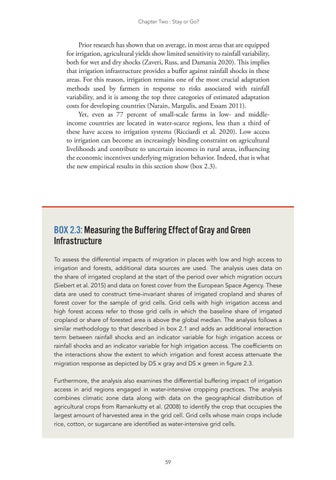Chapter Two : Stay or Go?
Prior research has shown that on average, in most areas that are equipped for irrigation, agricultural yields show limited sensitivity to rainfall variability, both for wet and dry shocks (Zaveri, Russ, and Damania 2020). This implies that irrigation infrastructure provides a buffer against rainfall shocks in these areas. For this reason, irrigation remains one of the most crucial adaptation methods used by farmers in response to risks associated with rainfall variability, and it is among the top three categories of estimated adaptation costs for developing countries (Narain, Margulis, and Essam 2011). Yet, even as 77 percent of small-scale farms in low- and middleincome countries are located in water-scarce regions, less than a third of these have access to irrigation systems (Ricciardi et al. 2020). Low access to irrigation can become an increasingly binding constraint on agricultural livelihoods and contribute to uncertain incomes in rural areas, influencing the economic incentives underlying migration behavior. Indeed, that is what the new empirical results in this section show (box 2.3).
BOX 2.3: Measuring the Buffering Effect of Gray and Green Infrastructure To assess the differential impacts of migration in places with low and high access to irrigation and forests, additional data sources are used. The analysis uses data on the share of irrigated cropland at the start of the period over which migration occurs (Siebert et al. 2015) and data on forest cover from the European Space Agency. These data are used to construct time-invariant shares of irrigated cropland and shares of forest cover for the sample of grid cells. Grid cells with high irrigation access and high forest access refer to those grid cells in which the baseline share of irrigated cropland or share of forested area is above the global median. The analysis follows a similar methodology to that described in box 2.1 and adds an additional interaction term between rainfall shocks and an indicator variable for high irrigation access or rainfall shocks and an indicator variable for high irrigation access. The coefficients on the interactions show the extent to which irrigation and forest access attenuate the migration response as depicted by DS × gray and DS × green in figure 2.3. Furthermore, the analysis also examines the differential buffering impact of irrigation access in arid regions engaged in water-intensive cropping practices. The analysis combines climatic zone data along with data on the geographical distribution of agricultural crops from Ramankutty et al. (2008) to identify the crop that occupies the largest amount of harvested area in the grid cell. Grid cells whose main crops include rice, cotton, or sugarcane are identified as water-intensive grid cells.
59



